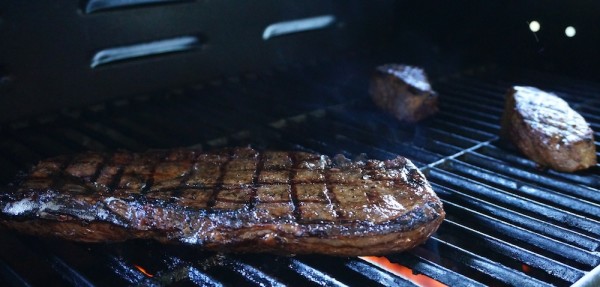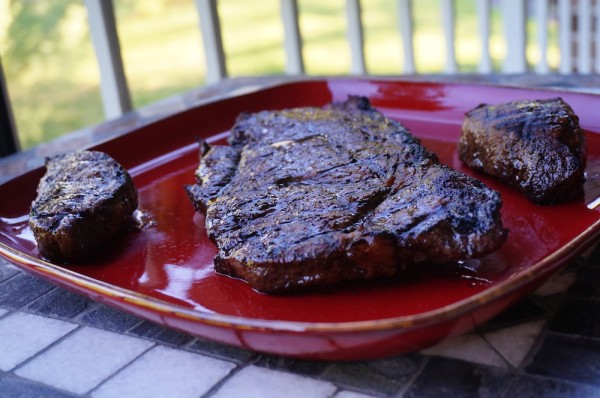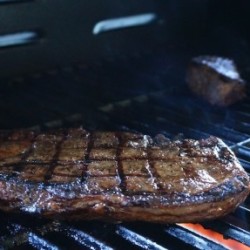My early memories of steak night are not happy ones. They involve flames. Flames bursting out of my mother’s broiler pan. Flames shooting up from the charcoal grill. I was convinced that home-cooked steak tasted a lot like charred leather. While I’ve had pretty good success with London Broil over the years, I decided premium cuts should be grilled by experts. I’d order these at restaurants. Why take the chance of ruining an expensive piece of meat?
Well, I’ve become more adventurous lately. And more nutrition-conscious. Convinced that meat from Lone Star Farm was high quality, I thought it might be worth learning to grill their steak. Ernie and Elmina Beiler, owners of the farm, allow their cows to graze freely, so they’re pasture fed for most of their lives. The cows are finished on a vegetarian diet, with no animal by-products. The Beilers even grow most of the feed right on their farm in Gap, and they don’t use any injected or implanted growth hormones or steroids. The animals are healthy, so they rarely need antibiotics. (Any cow that does need antibiotics is removed from their all-natural program.)
In his book, In Defense of Food, Michael Pollan says, “You are what you eat eats too. That is, the diet of the animals we eat has a bearing on the nutritional quality, and healthiness of the food itself. . . a diet of grass means much healthier fats. . . as well as appreciably higher levels of vitamins and antioxidants.”
Not only is this beef healthier, it’s so much tastier than supermarket beef. Like all fresh beef, Lone Star beef is aged to allow the enzymes in the meat to break down muscle tissue. This improves flavor and texture. While most beef is wet-aged in plastic shrink-wrap, Lone Star beef is dry-aged. This more expensive process exposes the meat to air so dehydration can further concentrate the meat’s flavor.
So—how did my adventure turn out? Great! I’m so hooked on Lone Star’s steak, I’ve become a restaurant critic. Not officially, but I rarely choose steak now when dining out. I’m usually disappointed, since it just doesn’t compare to Lone Star’s flavor and tenderness.
Here are some things I learned about grilling these amazing steaks:
- Thaw steaks thoroughly in the refrigerator.
- Let the meat come to room temperature before grilling. This will help it to cook more evenly. (Keep food safety in mind, and don’t ever let it get too warm.)
- Allow your grill to reach the proper temperature before putting the steaks on.
- Use tongs to turn the meat. Don’t pierce the steak; this drains the juices.
- Some people insist on leaving the grill open; others keep it closed till it’s time to turn the steak. You may have to experiment to figure out what works best with your grill.
- Turn it only once while grilling. This will create a nice crust.
- If a flame does flare up, you can spritz it with a tiny bit of water. (Keep a spray bottle handy.)
- When you think the steak is ready, use a quick-read thermometer to find the internal temperature, sticking the thermometer into the thickest part of the food, waiting until you get a steady reading, and then taking a second reading at another section of the meat. (Beef should be 140 degrees for medium rare, 155 degrees for medium).
- Do not grill past medium doneness. Steak will continue to cook when you remove it from the grill. Overcooking toughens the meat.
- After removing from the grill, let the steak rest for about five minutes before serving or carving. Or wrap it in foil and let it rest for up to 20 minutes.
For premium cuts such as Porterhouse, New York strip, T-bone, filet mignon, petite tender, Delmonico steak:
- Mix your own steak rub and keep it in a shaker jar. Use the following recipe or whatever concoction suits your fancy: ¼ cup each: dried basil, garlic powder, onion powder.
- Leave out the salt for now, because some say the salt draws out the meat’s juices.
- About 2-24 hours before grilling, brush the steak with olive oil. (That’s optional.) Shake the rub onto one side of the steak and gently massage it into the entire surface of the steak. Repeat on the other side of the steak. Wrap the meat in plastic wrap, put it on a plate or dish, and refrigerate for 2-24 hours. This allows the flavors to soak in.
- Just before grilling, sprinkle your steak with coarse salt and cracked pepper. This will give the meat a savory crust and classic steak house flavor.
- When you’re ready to cook, heat your gas grill to medium. If using charcoal, coals should be ready for grilling after about 30 minutes, when they are ash covered and very hot. Cooking times will vary depending on the size of the cut, but grill to 140 degrees for medium rare, 155 degrees for medium (see directions above for getting an accurate reading).
- For less tender cuts such as sirloin, round (including London Broil), ranch, and flat iron steak:
- Marinate the steak in the refrigerator. I always thought the longer I left meat in the liquid, the better. But I learned that marinating too long can make the meat too soft. So plan to do small pieces 2-3 hours. You can marinate a large (5+ pound) piece overnight.
- Use your favorite recipe, or use bottled barbecue sauce. Marinades should include some sort of acid (tomato, vinegar or fruit juice) to help tenderize the meat. A tasty marinade not only tenderizes, but also adds flavor as the meat absorbs the liquid. Mix the ingredients. Pour it into an impervious container such as glass, glazed ceramic or stainless steel– just large enough to contain the meat and the liquid. Place the steaks in the liquid. Turn the meat over to make sure it’s all been covered.
- Grill your meat to an internal temperature of 140 for medium rare, 155 for medium. These cuts should definitely not be cooked past medium, or they may be too tough.
For less tender cuts, try my favorite marinade recipe:
PrintMake Steak Night a Great Night with Free-Range Beef
- Category: Marinade
- Cuisine: Traditional
Ingredients
- ½ cup olive oil
- ¼ cup Worcestershire sauce (contains vinegar)
- 6 Tbsp soy sauce
- 2 Tbsp minced garlic
- ¼ cup chopped onion
- 1 Tbsp pepper
- 1 Tbsp rosemary
- 1 Tbsp A-1 steak sauce (contains vinegar and tomato)
Instructions
- Mix all ingredients together.



